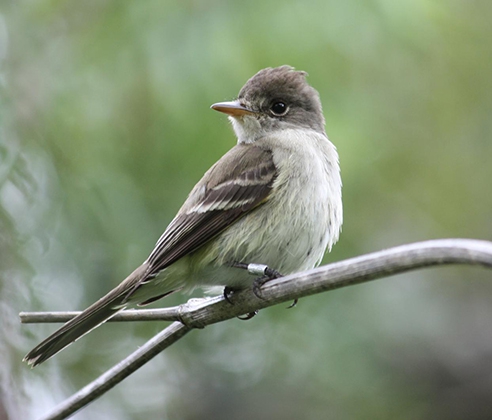Southwestern Willow Flycatcher
In 1995, the Southwestern willow flycatcher (SWFL) was federally listed as endangered by the U.S. Fish and Wildlife Service. In 1996, the SWFL was listed as endangered by New Mexico State.
-
Scientific Name: Empidonax traillii extimus
-
Species Abbreviation: SWFL
-
Status:
Federally Endangered Species;
New Mexico State Endangered Species;
New Mexico Species of Greatest Conservation Need
- Documents
-
View documents from the Program Library.
See All documents

Photo Credit: Shannon Caruso
- National Park Service Southwestern Willow Flycatcher
- New Mexico Game and Fish Threatened and Endangered Species of New Mexico 2018 Biennial Review
- New Mexico Department of Game and Fish Wildlife Notes
- U.S. Fish and Wildlife Service Environmental Conservation Online System
- U.S. Fish and Wildlife Service Southwestern Willow Flycatcher
- U.S. Fish and Wildlife Service Southwestern Willow Flycatcher Final Recovery Plan
- Biota Information System of New Mexico (BISON-M)
- New Mexico Avian Conservation Partners
- Southwestern Willow Flycatcher Facts
Description
The Willow Flycatcher (Empidonax trailii) is one of ten North American flycatcher species in the genus Empidonax and the Southwestern Willow Flycatcher (E. t. extumus) is one of four subspecies of the Willow Flycatcher. The SWFL is a small perching bird that is less than 5.75 inches long and weighs 11-12 grams. Similar to the other Willow Flycatcher subspecies, the SWFL has a white eye-ring and olive-brown upperparts with two white wing bars, a white throat, a pale olive breast, and a light yellowish body. The males and females are similar, but juveniles differ from adults by having buffy wing bars. The structure of the distinctive sneezy fitz-bew song differs among the four subspecies of Willow Flycatcher, but the most reliable method for differentiating between subspecies in the field is geographic location during the peak of breeding season.
The SWFL breeds in late spring/early summer, generally arriving to its breeding grounds in May and departing for its wintering grounds in August. SWFLs breeding at higher elevation areas have a delayed breeding chronology. During the 2 to 4 months of the year that SWFLs are on the breeding grounds, they require dense riparian habitats greater than 0.6 ha in size that have or are near surface water or saturated soil. These microhabitat and vegetation conditions support the SWFL’s required diet of insects, such as dragonflies, ants, bees, sawflies, gnats, mosquitos, cicadas, and aphids. Males establish and defend territories through singing and aggressive behavior. Females also sing, sometimes loudly and persistently, so not all loudly singing individuals can be presumed to be males. Singing birds generally choose high perches from which to sing and can begin singing in the pre-dawn hours (i.e., several hours before sunrise). There are periods when the SWFL rarely sings, such as late in the breeding season or in very small populations. Sometimes the only indication that SWFLs are breeding in an area is hearing their soft call notes or seeing silently flycatching or perched birds during the peak of the breeding season.
Distribution
The SWFL is a Neotropical migrant that breeds in the Southwestern U.S. and overwinters in Mexico, Central America, and northern regions of South America. The species' historical range is similar to its current distribution, but population numbers have declined dramatically over the years due to loss, fragmentation, and degradation of riparian ecosystems. The SWFL breeding range currently encompasses the southwestern U.S. from southern California, through southern Nevada, southern Utah, Arizona, New Mexico, and southwestern Colorado. Historically, its range also included western Texas and extreme northwestern Mexico. As other Willow Flycatcher subspecies breed nearby and migrate through the SWFL's breeding range, Willow Flycatchers detected along the Middle Rio Grande only can be identified as the endangered Southwestern subspecies if there is evidence of breeding (e.g., nests, fledglings) or birds are detected during the peak of the breeding season (generally mid-June to mid-July).
Recovery Efforts
The U.S. Fish and Wildlife Service implemented and completed a recovery plan for the SWFL in 2002, when it was estimated that only 900 to 1,100 pairs remained. A study in 2007 led to an increase in the population estimate to 1,299 pairs. The decline of the SWFL is believed to be primarily due to degradation and loss of native riparian habitats. One cause of habitat loss is livestock overgrazing. The Brown-headed Cowbird (Molothrus ater) also threatens the SWFL populations by reducing nesting success through brood parasitism.
In 2013, the U.S. Fish and Wildlife Service revised the SWFL critical habitat designation. The current habitat designation aligns with recovery plan goals and identifies 1,975 stream kilometers in the Southwestern U.S. as critical SWFL habitat. MRGESCP signatories have collaborated to conduct studies, monitoring, surveys, and habitat restoration to benefit the SWFL.
